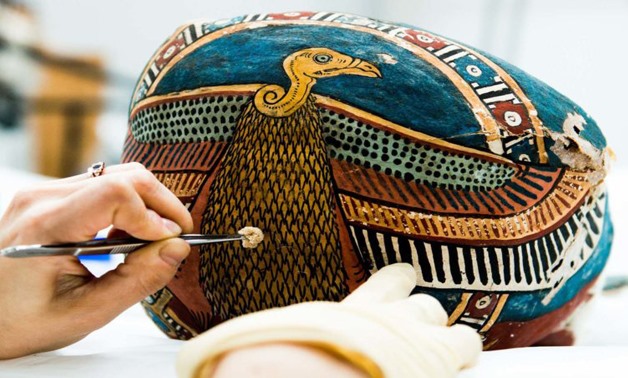
Mummy mask, Courtesy - of - National - Museums
CAIRO – 12 May 2017: The Liverpool Museum created the biggest ever Egyptology gallery on May 28. It is the UK’s largest Ancient Egyptian gallery after the British Museum, 1,000 square metres. The gallery will take its visitors back to 5,000 years of history, mainly from the time of the first settlers in the Nile Valley till the Roman Empire.
The gallery’s collections are divided in seven themes which are 5,000 years, Collection Highlights, River Nile, People of Egypt, African Kingdoms, Afterlife and the Mummy Room. The gallery’s valuable objects have been collected over more than 150 years. It will host around 1,000 objects, of which many of them have never been on public display before.
The extended gallery will witness the reopening of World Museum’s Mummy Room for the first time in 150 years. The mummy room will include about ten mummies. This room is expected to be the UK’s largest display of mummies after that of the British Museum.
“Our mummy collection is world-renowned and has always proved to be incredibly popular with visitors of all ages,’’ said Steve Judd, Director of World Museum.
The ten mummies will include four women, a temple musician, a Nubian lady buried in her bed sheets, two mummified women in their late teenage years, five men and a five year old boy.
“Until now, space restrictions have limited us from showing the full scope of our collections. By expanding the gallery, we look forward to wowing visitors with never-before seen objects displayed in new and exciting ways,” Judd added.
The gallery will organise programmes and events including talks, performances and family activities.
Some of the amazing objects you will see when you visit the new Egyptology gallery
The mummy’s mask
This precious cartonnage mummy mask that was never displayed before, dates back to the Ptolemaic Period. The golden plated mummy was found in fragmentary state. Despite this fact it has some amazing details like the crown on the head showing the vulture goddess Nekhbet with her patterned wings.
 A mummy’s mask in conservation. © Courtesy of National Museums Liverpool..
The Book of the Dead
A mummy’s mask in conservation. © Courtesy of National Museums Liverpool..
The Book of the Dead
The only almost complete version of (the book of the dead) will be displayed in the gallery, only one end of the fragile papyrus is torn.
 The Book of the Dead. Ptolemaic Period (about 332 BC) Excavated at Hissaya by Liverpool University, 1905 © Courtesy of National Museums Liverpool.
The coffin of Haty
The Book of the Dead. Ptolemaic Period (about 332 BC) Excavated at Hissaya by Liverpool University, 1905 © Courtesy of National Museums Liverpool.
The coffin of Haty
This brightly painted coffin named Haty. Haty was a man who lived in the 8th century BC. The coffin is from Sir Robert Mond of Wigan collection.
 The coffin of Haty. © Courtesy of National Museums Liverpool
Florence Nightingale’s amulets
The coffin of Haty. © Courtesy of National Museums Liverpool
Florence Nightingale’s amulets
The world-wide famous inspiring nurse Florence Nightingale collected these amulets when she toured Egypt in the winter of 1849.
 Florence Nightingale’s amulets. © Courtesy of National Museums Liverpool
The mask of Hor Wen Nefer
Florence Nightingale’s amulets. © Courtesy of National Museums Liverpool
The mask of Hor Wen Nefer
Hor-wen-nefer was a ‘royal relative’ who lived in the Macedonian Greek rule era. His coffin with a golden plated face was considered one of the finest and best preserved.
 Hor-wen-nefer. © Courtesy of Dave Jones
A ritual ivory clapper
Hor-wen-nefer. © Courtesy of Dave Jones
A ritual ivory clapper
It is hand-shaped and decorated with the head of Hathor, the goddess of love, music and joy. It was first found in a tomb with a matching clapper that is now in the Egyptian Museum.
 Ivory clapper. Courtesy of National Museums Liverpool
The coffin of Taenty
Ivory clapper. Courtesy of National Museums Liverpool
The coffin of Taenty
The coffins of a lady called Taenty came from an undisturbed tomb found by John Garstang’s excavations at Kostamneh in 1906.
The ring of Ahmenotop II
In the Levant and Nubia Pharaohs would give gold rings inscribed with their name as a reward to people in their service. This gold signet ring is inscribed with the name of Amenhotep II on one side and on the other is the epithet, “the perfect god, son of Amun, mighty lord.”
The coffin lid of Padiamun
Padiamun was the doorkeeper of the Amun temple at Karnak and was the son of Penhay and Nehemesbastet. Padiamun means ‘he whom Amun gave.’ He was buried within three coffins.
A lion hunt scarab of Amenhotep III
King Amenhotep III sent Hundreds of inscribed scarabs. Amenhotep III achievements were registered in these early versions of postcards or tweets. This one talked about how strong and brave was Amenhotep III as he for killed 102 lions in the first ten years of his reign.
It is worth mentioning that the National Museums Liverpool contains eight venues that attract 3 million visitors every year which are the Museum of Liverpool, World Museum, the Walker Art Gallery, Merseyside Maritime Museum, International Slavery Museum, Border Force National Museum, Sudley House and the Lady Lever Art Gallery.






Comments
Leave a Comment